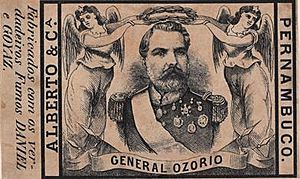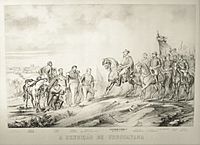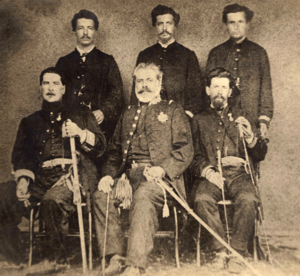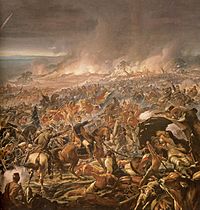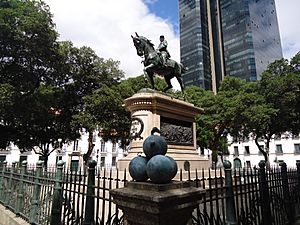Manuel Luís Osório, Marquis of Erval facts for kids
Quick facts for kids
Marquis of Erval
|
|
|---|---|
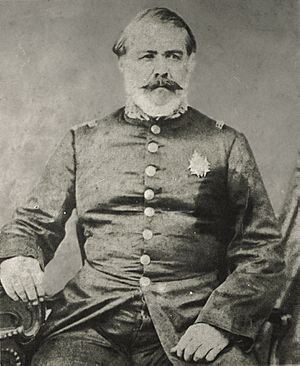
The Marquis of Erval around age 60
|
|
| Born | May 10, 1808 Conceição do Arroio, State of Brazil, Portuguese America |
| Died | October 4, 1879 (aged 71) Rio de Janeiro, Empire of Brazil |
| Allegiance | |
| Branch | Imperial Brazilian Army |
| Service years | 1824–1876 |
| Commands held | Army of the Triple Alliance |
| Battles/wars | Brazilian War of Independence Cisplatine War Ragamuffin War Platine War Paraguayan War |
| Spouse(s) | Francisca Fagundes |
| Children | Fernando Luís Osório Adolfo Luís Osório Manuela Luísa Osório Francisco Luís Osório |
| Other work | Minister of War |
| Signature | |
 Coat of Arms of the Marquis of Herval |
|
Manuel Luís Osório, Marquis of Erval (born May 10, 1808 – died October 4, 1879) was a famous Brazilian soldier and politician. He joined the Imperial Brazilian Army when he was just fifteen years old. Osório rose through all the ranks because of his amazing skills as a soldier, earning him the nickname "The Legendary".
He took part in many important military events in the Río de la Plata region during the 1800s. He is especially remembered as a hero of the Paraguayan War. In 1962, he was named the patron (or protector) of the Cavalry Branch of the Brazilian Army.
Contents
Biography
Osório's Early Life
Manuel Luís Osório was born on May 10, 1808. His birthplace was a village called Nossa Senhora da Conceição do Arroio, in Rio Grande do Sul, Brazil. He grew up on his mother's family farm.
His father, Manuel Luís da Silva Borges, was a respected and decorated soldier. He fought in wars between 1811 and 1821 to control the Río de la Plata region. Osório's mother, Ana Joaquina Luísa Osório, came from a family of landowners.
On October 15, 1835, Osório married Francisca Fagundes. They had four children: Fernando, Adolfo, Manuela, and Francisco.
Starting His Military Career
Osório was the fourth of 14 children in his family. He learned to read and write without going to a regular school. On May 1, 1823, when he was only 15, he joined the Cavalry of the Legion of São Paulo as a volunteer.
He fought alongside his father's regiment in the War of Independence of Brazil (1822-1825). His first battle was on May 13, near Montevideo, against Portuguese cavalry. A year later, he became a cadet, and then a second lieutenant.
In 1824, Osório planned to study at the Military School. However, a new war in the south of Brazil, the Cisplatine War (1825-1828), stopped his studies. On October 12, 1825, he fought bravely in the Battle of Sarandí. He was the only officer in his group to survive and even saved his commander's life.
In 1827, Osório continued fighting. At the Battle of Ituzaingó on February 20, his troops were the only Brazilian ones not broken apart. He was promoted to lieutenant in October. After peace was made, he returned home and became involved in politics with the Liberal Party.
Fighting in the Ragamuffin and Platine Wars
In 1835, the Ragamuffin War started in Rio Grande do Sul. This was a rebellion that lasted ten years. Osório first fought with the rebels. But when the movement wanted to create a separate republic in 1836, he disagreed. He then joined the Imperial Brazilian Army to help keep Brazil united.
He became a captain in 1838 and a major in 1842. In 1844, he wanted to retire, but the Army refused. Instead, they made him a lieutenant colonel. He helped negotiate the peace treaty that ended the war in 1845. After the war, Emperor Pedro II of Brazil visited the province, and Osório was chosen to escort him.
In 1851, Osório was sent to Montevideo again because of problems in the Río de la Plata region. He fought against the Argentine president Juan Manuel de Rosas. He showed great courage in the Battle of Monte Caseros in 1852. He was promoted to colonel on the battlefield for his bravery.
In 1855, Osório was given command of the border of São Borja. He was promoted to brigadier in 1856. Later, he received the title Marquis of Herval. He also took part in another intervention in Uruguay to help Brazil's allies. This intervention led to the start of the Paraguayan War.
The War of the Triple Alliance
The Paraguayan War (1864-1870) began when Paraguay attacked Brazil and Argentina. In 1865, Brazil, Uruguay, and Argentina formed the Treaty of the Triple Alliance against Paraguay. Osório was a very respected military leader at this time. He had been fighting for 42 years.
On March 1, 1865, he was given command of the 1st Corps of the Imperial Army. The overall command of the allied forces went to Argentine General Bartolomé Mitre.
On July 8, 1865, Osório was promoted to Field Marshal. He helped in the Siege of Uruguaiana. On September 18, the Paraguayans surrendered after months of fighting. Emperor Pedro II was present at this surrender.
On May 2, 1866, Osório fought in the Battle of Estero Bellaco. On May 24, 1866, he was at the Battle of Tuyutí, which was the largest battle in South American history. He played a key role in leading the center of the Brazilian forces. He wrote: "Glory is the most precious reward of the brave."
He was seriously wounded in a battle on July 15, 1866. Because of his injury and the long recovery needed, Osório handed over command of the Brazilian troops.
He spent a year in Rio Grande do Sul, gathering new soldiers. On June 1, 1867, he was promoted to Lieutenant General. On July 25, Osório returned to the front lines. He commanded the 3rd Corps of the Imperial Army. He worked with Marshal Luís Alves de Lima e Silva, who was a long-time friend.
Osório helped plan attacks against the Fortress of Humaitá. This fortress was blocking the allied forces from reaching Asunción. On July 25, Osório's troops captured the Fortress of Humaitá. He replaced the Paraguayan flag with the Brazilian flag.
After Humaitá fell, Osório fought in the Battle of Ytororó and the Battle of Avay in December 1868. In the Battle of Avay, he was shot in the face, breaking his jaw. He hid his wound with a poncho and kept encouraging his men. He said, "Courage, comrades! Stop the rest!"
His empty carriage was kept at the front of the troops so his soldiers would think he was still leading them. Osório had to return to Brazil to recover. He missed the fall of Asunción in January 1869. His family's coat of arms has three golden stars, showing the wounds he got in the Battle of Avay.
On March 22, 1868, Gaston of Orléans, Count of Eu, became the new Commander-in-Chief. He invited Osório to return to Paraguay. Osório took command of the 1st Army Corps on June 6. The Count of Eu admired Osório greatly.
On August 12, Osório's forces captured the Peribebuí Fortifications. On November 24, 1868, Osório left the war for good because his health got worse. On his way home, he learned that his wife had died.
Later Life and Legacy
Osório received several honors for his service. He became Baron of Herval in May 1866, Viscount of Herval in 1868, and Marquis of Herval in 1869. After the war, the victory at the Battle of Tuyutí was a major Brazilian military celebration, and Osório was seen as the main hero.
Despite being an important military and political figure, Osório faced financial difficulties in his last years.
After the war, Princess Isabel, who was ruling Brazil at the time, made Osório a Senator for Rio Grande do Sul. He became a Senator on January 11, 1877. In a speech, he said: "The military uniform does not smother the citizen in the soldier's bosom." Although he was a republican when he was young, he later became a strong supporter of the monarchy.
On June 2, 1877, he was given the rank of Marshal of the Army. In 1878, Osório was appointed Minister of War. He held this position until his death on October 4, 1879, in Rio de Janeiro. He was 71 years old and died from pneumonia.
Osório's Legacy
Osório's death, along with other loyal military leaders, created space for a new generation of soldiers. These new leaders were less loyal to the monarchy. Osório believed that soldiers should always serve their country and not use their power for bad reasons. He said: "It would be a wretch who, having fought the external enemy with the weapons of war, would then place those same weapons at the service of despotism, persecution and violence against his countrymen."
His body was first placed in the chapel of the War Arsenal. Later, it was moved to the Asylum of the Invalides of the Homeland. On December 3, 1887, his remains were moved to the Church of Santa Cruz dos Militares. Finally, on July 21, 1892, his body was moved to a crypt under his equestrian statue in Praça Quinze de Novembro, Rio de Janeiro. This statue was made from the bronze of cannons captured in the War of the Triple Alliance. On December 11, 1993, his body was moved one last time to a vault near his birthplace.
Honors
Osório received many honors throughout his life. He was given the titles Baron of Herval (May 1, 1866), Viscount of Herval (April 11, 1868), and Marquis of Herval (December 29, 1869).
In 1934, his hometown, Conceição do Arroio, was renamed Osório in his honor. The EE-T1 Osório, a Brazilian tank prototype, was also named after him. His name is written in the Steel Book at the Tancredo Neves Pantheon of the Fatherland and Freedom in Brasília. Many streets, squares, and institutions across Brazil are named after him.
See also
 In Spanish: Manuel Luis Osório para niños
In Spanish: Manuel Luis Osório para niños



